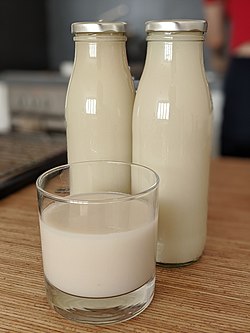Invention
Soy milk and almond milk (besides coconut milk) predate all other plant-based milks, including oat milk, both as cultural and commercial products. [4] Since the early 20th century, soy milk made its way from Asia to European and American grocery stores, initially as a dairy substitute due to lactose intolerance. [2] The increase in consumption of soy milk since its global distribution created a large market for plant-based beverages like oat milk. [1] There are records of oat based beverages that go back to the 18th century; however, one of the first recorded instances of a commercial oat-based plant beverage was in the early 1990s, when Rickard Öste developed oat milk. [5] [6] [13] Öste was working as a food scientist at Lund University in Lund, Sweden, researching lactose intolerance and sustainable food systems, when he invented the drink. [5] [6] Soon after, Öste founded Oatly, the first commercial manufacturer of oat milk. [5]
History of market expansion
The pioneer in commercial oat milk, Oatly, had its products in 7,000 coffee shops and grocery stores, as of 2019, [7] but was not the only prominent oat milk producer. [5] [14] Oat milk is available in many countries under various brands. [15]
In 2018, there were numerous oat milk shortages from unprecedented demand in Europe and North America, highlighting the strong consumer demand for this product. [3] [16] To meet the American demand, Oatly opened a new factory in New Jersey in April 2019, producing 750,000 US gallons (2,800,000 L; 620,000 imp gal) per month of oat milk base, and announced plans for a Utah-based factory three times larger to open in early 2020. [7] In 2019, retail sales of oat milk in the United States were $29 million, up from $4.4 million in 2017. [7] During 2020, oat milk sales in the United States increased to $213 million, becoming the second most consumed plant milk after almond milk ($1.5 billion in 2020 sales). [17]
Oat milk ice cream, yogurt-like products, and coffee creamers, were common in 2019, [7] with expanded uses in coffee shops, such as Starbucks, [3] [9] and growth into new markets, such as China. [18] Growth in the oat milk market is partly attributed to its relatively low environmental impact, low land and water needs, and rising vegan dietary practices in developed countries. [3] [7] [10]
From 2019 to 2020 in the United States, oat milk sales increased 303% to US$213 million, with refrigerated oat milk having nearly ten times the sales of shelf-stable oat milk. [17] Consumer analysis of the growth in oat milk consumption indicates its market growth derives from the dairy-like taste, health perception, and environmental sustainability, which contrasts with the high water demand of growing almonds. [8] [10] [12] Oat milk foams and mixes in other beverages, like coffee, in ways similar to milk. [8] Over 2020-21, oat milk sales increased 151%, with it becoming the second-most consumed plant milk after almond milk. [19] On 20 May 2021, Oatly – the world's largest oat milk manufacturer – became a publicly traded company on the NASDAQ exchange, having a market value of US$13 billion on that day. [20]
